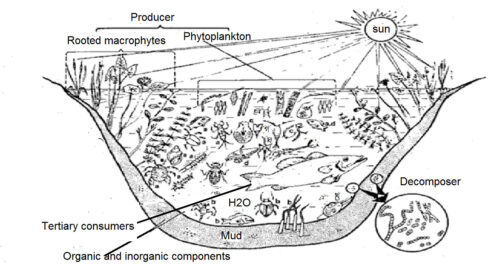Based on the need for subsurface habitat or living independently, different organisms in the stagnant water environment are classified. Organisms that need the bottom of a reservoir to live are called pedonic organisms, while organisms that can live independently are called limnetic organisms. Biotic communalities of lakes and ponds mean biota that live together and make interaction with their environment. Moreover, aquatic organisms are classified based on size and habitat.
Neuston
Such organisms live at the junction of air and water. These include floating plants such as aphids and a variety of animals. Organisms such as aquatic striders that live above the junctions of air and water. These are called epineustons. Insects such as diving beetles and back swimmers, on the other hand, spend most of their time downstream at the junction of air and water and they collect most of their food from there. These animals are called hyponeuston.
Plankton
Plankton can be seen in all types of water bodies except high-flowing rivers. Plankton are those small plants and animals whose mobility is so limited that they cannot keep up with the current. The vast majority of plankton in the aquatic environment is therefore controlled by currents. Most plankton (phytoplankton and zooplankton) can control vertical distribution with little movement. Some animal plankton or zooplankton are more active than their miniature bodies and can travel relatively long distances. However, their size is so small that their spread is greatly controlled by the current. Such plankton is called a nectoplankton.

Ecosystem of stagnant water(Ponds)
Nekton
Nectons are swimming animals that are found in all water bodies except the high flowing river. They tend to be relatively large and strong enough to keep up with current. They range in size from 2 mm long stagnant swimming insects to the world’s largest animal, the blue whale.
Benthos
Benthos are those animals that live at the bottom of ponds. They are found in all types of water bodies. The benthos that lives above the junction of sediment and water are called benthic epifauna. And all the benthos that lives in sediments are called infauna.
Biotic Communities of Litoral Zone
The littoral zone of stagnant water bodies is rich in biodiversity. The littoral region of the lake is rich in pedonic vegetation. Rooted plants can be seen especially in those areas where light penetrates effectively to a depth. Emergent plants grow in the riparian areas of water bodies. The rooted parts of these plants are attached to the soil near the shore and the chlorophyll-bearing parts are located on the surface of the water. These plants occasionally contain Typhala, Scirpus, Sagitaria and Pickerel weeds. Deeper than the shore, there are floating leafy plants such as water lillies- Nymphaea, Potamageton.
Deeper in the littoral region of the lake are rooted weeds, but they are completely submerged. The major phytoplankton of the region are diatoms (microbes), blue green algae (Microcystis, oscillatoria), green algae (Cosmarium, Staurastrum), and holophytic flagellets.
High density of animals can be seen in the littoral region. The fauna in this region is divided into several specific communities. Nymphs, crayfish, isopods, insects, snails and oysters of various types of dragonflies can be seen that live in the mud of the bottom or above the mud. Other animals live in plants that grow on the bottom or in any other object that grows from the top or from the bottom. These include protozoa-like larvae of Vorticella, Stentor, Dysticus, Laccotrohes, leech such as Glossophonia; Dragonfly, Damsel flies nymphs, Rotifers (Brachionus, Keratella, Filinia, Asplanchna, Lecane, and Monostylla), Bryozoa, Hydra, Lymnaea, Bellamya and others. With a few exceptions, rotifers such as Brachionus, Keratella, Trycocera and Crustacea such as Cyclops, Daphnia, Moina etc, depend on aquatic plants in one way or another way for their habitats.
The larvae of Chironomus are found in rooted plants. Planarians can be seen under the leaves of floating plants. Zooplankton in the littoral region are water flea such as Daphnia, Moina, Rotifers such as Brachionus, Keratella and Ostracods. The nectons are Paramecium, Euglena, Ranatra, Coroxa, Dysticus, Culex larva, Chaoborus, Gerris, Gyrinus. The living creatures of this region are aquatic beetles and spiders and numerous protozoans. Many pond fish species such as Sunfish, Top minnows, Bass, Pike and Gar also spend most of their time in the littoral region.
Biotic Communities of Limnetic Zone
The limnetic zone varies greatly in water level, temperature, and oxygen holding capacity at different times. In some Himalayan lakes, which originate from glaciers, the height of water pillars increases rapidly in early summer. Different types of protozoa prepare for cyst formation in adverse ecological environments. Tardigrades such as Macrobiotus, Rotifer such as Rotaria, Philodina, Copepods, snails and frogs live in the limnetic zone. Inactive and low-moving animals do not live in the area. Many microscopic creatures (Volvox, Euglena, Phacus), fish also occupy this area. The limnetic zone has an abundance of autotrophic organisms.
Biotic Communities of Profundal Zone
The area is inhabited by bacteria, fungi, oysters, bloodworms, annelids and other small animals. They can live in low light and low levels of oxygen. Self-eaters cannot make food in the profoundal region. Their main source of energy is decomposed organic matter from the limnetic zone. All the organisms in this region are parasitic. These are Detrivores or Carnivores. Most of the large fish in the lake live in the dark waters of the hypolimnion layer. In addition, decomposed organic matter and river-borne organic matter from the limnetic zone accumulate in the lake and provide food for the animals of the profoundal region.
Benthos of Lake Bottom
There may be real rocks at the bottom of the new lake. Rotten organic matter accumulates at the bottom of old lakes, forming muddy or sandy bottoms that make benthos habitat. The Benthos community in the region includes some species of insect larvae such as Midge larvae, pit-dwelling May-fly, oysters, snails and tube worms.
